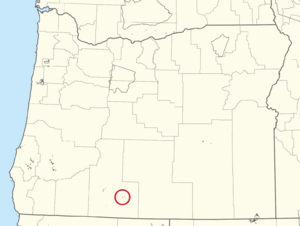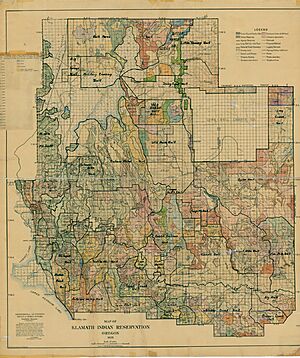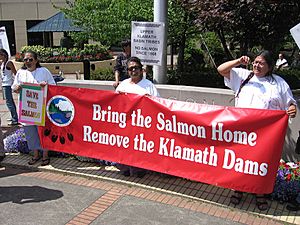Klamath Tribes facts for kids
| Total population | |
|---|---|
| 5700 | |
| Regions with significant populations | |
| Languages | |
| English, formerly Klamath | |
| Related ethnic groups | |
| Modoc, Yahooskin, Klamath people |
The Klamath Tribes are a group of Native American people. They are officially recognized by the United States government. This group includes three tribes: the Klamath, Modoc, and Yahooskin. These tribes have lived for a very long time in what is now Southern Oregon and Northern California. Today, the main office for the tribal government is in Chiloquin, Oregon.
Contents
History
Early Life and Traditions
For thousands of years, the Klamath people lived successfully in their rich homeland east of the Cascade Mountains. They believed that the Creator provided everything they needed. Hard work was important to them, and elders taught that working hard earned respect.
The Klamath people were very resourceful. During long winter nights, they lived on food they had saved from the warmer seasons. In late March, when food supplies were low, large fish called C'waam (Lost River sucker) would swim up the Williamson, Sprague, and Lost River. The Klamath still celebrate the Return of C'waam Ceremony on the Sprague River.
Klamath families and groups were connected by loyalty and shared food. They lived in many places, including along the Klamath Marsh, near Agency Lake, by the Williamson River, on Pelican Bay, and in the Sprague River Valley.
Before Europeans arrived, the Klamath people had a unique idea about wealth. They believed in individual wealth and prestige, meaning that people worked hard to gain possessions and improve their social standing. This focus on hard work and gaining things helped the Klamath when they first met white settlers. They were able to accept some new ways of life easily.
Meeting Newcomers
In 1826, Peter Skene Ogden, a fur trapper, was the first white person known to visit Klamath lands. Other trappers followed, and their journals mentioned places like Hunter's Hot Springs. They also reported being attacked by Native Americans.
In the 1830s and 1840s, explorers like John C. Fremont mapped the area and named natural features like Christmas (Hart) Lake.
The Reservation Era
In 1864, the Klamath Tribes signed a treaty. They gave up a lot of their land, about 6 million acres. However, they kept their rights to hunt, fish, and gather food on the lands that were set aside for them forever. These rights are still important today.
After the treaty, members of the Klamath, Modoc, and Yahooskin tribes were moved to the Klamath Indian Reservation. There was some conflict between the Klamath and Modoc tribes. A group of Modoc left the reservation, leading to the Modoc War (1872–73). After the war, the U.S. Army forced them back to Oregon.
Missionaries, settlers, and ranchers came to the area. The Klamath people began to adapt to new ways. An early Indian agent, Rev. Linus M. Nickerson, helped plan improvements.
A sawmill was built in 1870, and tribal members began selling lumber. By 1873, they were selling wood to the Fort Klamath military post and others. By 1881, tribal members had built a boarding school, offices, homes, and miles of fences. They were also working on a new police station. When a railroad was built in 1911, the timber on the reservation became very valuable. This timber supported the economy of Klamath County for many years.
Klamath tribal members were quick to use new economic chances. Both men and women learned new skills. They took many different jobs on the reservation and at the Fort Klamath military post.
Horses were very important for wealth before the reservation. So, ranching and owning cattle were easily accepted. The Indian Agency also leased some tribal lands to ranchers. Today, the cattle business is still important. The tribes also had old trade networks, which helped them start successful freighting businesses. By 1889, 20 tribal teams worked all year to supply goods in the growing county.
The Termination Act
By the 1950s, the Klamath tribes were among the richest tribes in the United States. They owned and managed a huge forest of Ponderosa pine trees. The Klamath were self-sufficient, meaning they paid for all the government services their members used.
In 1954, the U.S. Congress passed the Klamath Termination Act. This law ended the special relationship between the federal government and the Klamath tribe. It meant that federal supervision over Klamath lands and federal aid to the Klamath ended.
This act was part of a larger government policy to end federal ties with many Native American tribes. The Klamath were chosen for termination because they seemed to be doing well financially. They were self-sufficient because of their rich timber resources.
The Klamath were also thought to be ready for termination because they had adopted many modern ways of life. Their traditions also valued individualism, which seemed to fit with the idea of them becoming more like other American citizens.
However, many Klamath leaders were not asked if they wanted termination. When tribal members were finally allowed to vote, they could not say no to termination. They could only choose how they would be paid for their land. Out of 2,133 tribal members, 1,660 (78%) chose to leave the tribe and receive a payment of about $43,000 each in 1961. Those who stayed became part of a tribal management plan.
The termination of the Klamath Reservation included three tribes: the Klamath, Modoc, and Yahooskin.
Becoming a Tribe Again
In 1978, the western Modoc tribe had their tribal status restored. Almost ten years later, in 1986, the Klamath Restoration Act was passed. This law brought the Klamath Tribes back as a sovereign (self-governing) nation. Even though their land base was not fully returned, the Klamath Tribes were asked to create a plan to become economically self-sufficient again. Their plan shows their commitment to helping the local economy.
Klamath Lands Today
Today, the Klamath Indian Reservation is made up of twelve small pieces of land in Klamath County. These lands are near the towns of Chiloquin and Klamath Falls. The total land area is about 1.25 square kilometers (308 acres). Like many Native American tribes, not many Klamath tribal members live on the reservation lands today.
There are over 5,700 enrolled members in the Klamath Tribes. The main government office is in Klamath County, Oregon. Most tribal lands were sold when Congress ended federal recognition in 1954. Some lands were given back when recognition was restored. The tribal government now offers services throughout Klamath County.
Water Rights and Treaties
Since 2001, there has been a disagreement over water rights in the Klamath Basin. This dispute involves the Klamath Tribes, local farmers, and fishermen along the Klamath River.
When the Klamath tribe signed the 1864 treaty, they gave up a lot of land. But they kept their rights to fish, hunt, trap, and gather from the lands and waters as they had always done.
Even when the federal government ended its relationship with the Klamath Tribes in 1954, the law stated that it would not take away the tribe's water rights or fishing rights from the treaty.
Both California and Oregon have tried to challenge the Klamath tribe's water rights, but they have not succeeded. In 2001, local farmers tried to claim water rights but lost their cases. In 2002, a judge ruled that the Klamath Tribes' right to water came before the rights of non-tribal farmers who used irrigation.
The Klamath Tribes are pushing for dams on the upper rivers to be removed. They believe this will help improve fishing for salmon and make the salmon runs stronger.
Tribal Government
The Klamath Tribes are led by a Tribal Council. The members of the council are chosen by democratic elections and serve for three years.
Here are the current tribal government leaders for 2022-2025:
- Chairman: Clayton Dumont
- Vice-Chairwoman: Gail Hatcher
- Secretary: Roberta Frost
- Treasurer: Brandi Hatcher
- Councilperson: Willa Powless
- Councilperson: Natalie Ball
- Councilperson: Les Anderson
- Councilperson: Ellsworth Lang
- Councilperson: Rose Treetop
- Councilperson: Jeannie McNair
Economy
The Klamath Tribes opened the Kla-Mo-Ya Casino in Chiloquin, Oregon, in 1997. It is located on 40 acres (16 hectares) of land along the Williamson River. The casino brings in money that the tribe uses to support its government and invest in projects that benefit the tribal members.
See also





